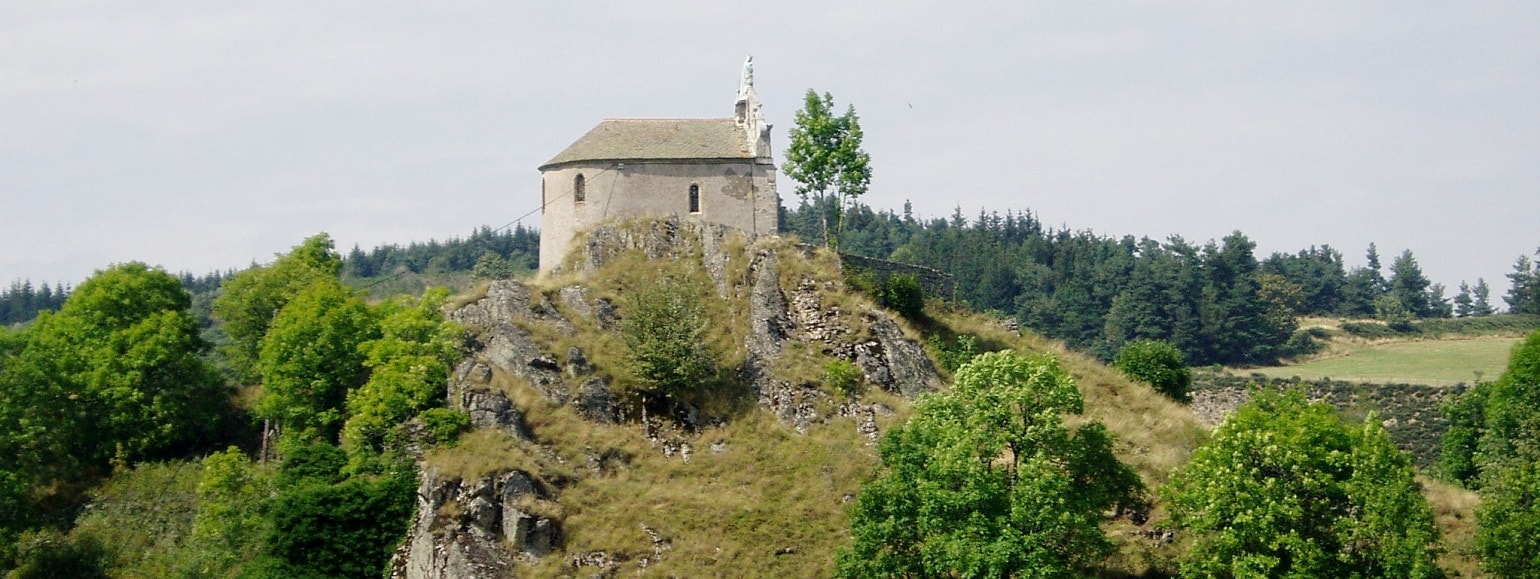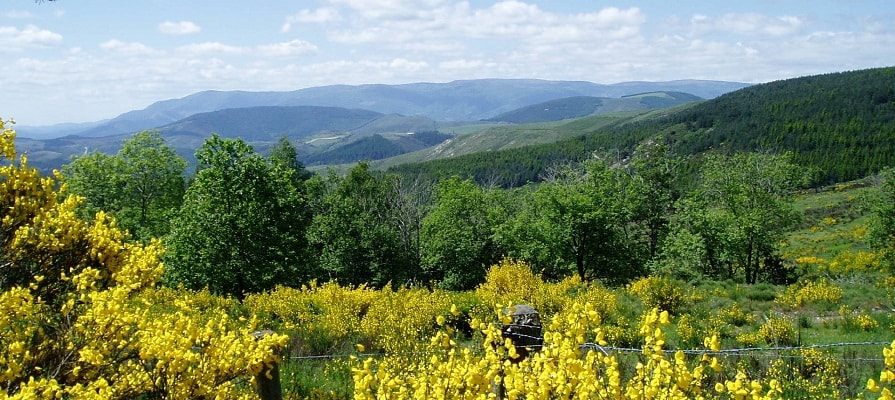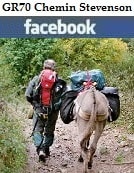 |
The Scottish writer Robert Louis Stevenson undertook a trip as a recluse through the Cevennes (GR70) to search for the heart of the camisards from Auvergne to Languedoc region. |
Across the Cevennes with Robert Louis Stevenson

|
 |
The Scottish writer Robert Louis Stevenson undertook a trip as a recluse through the Cevennes (GR70) to search for the heart of the camisards from Auvergne to Languedoc region. |

|
 At the end of the last
century, the Scottish writer Robert Louis Stevenson undertook a voyage as a recluse through the Cevennes to search for the heart of
camisarde. On the basis of Monastier sur Gazeille with for his only partner an ass, it will end
to Saint Jean of Gard after a high tour of and be recorded in the book " Travels with an ass through the Cevennes ". It is the lozerienne part of this tour that we invite you to follow. In car, on
foot, horse, with an ass: whatever you wish according to the time you have. The stages suggested are of top-notch quality and will let you re-live the very footsteps of R.L. Stevenson.
At the end of the last
century, the Scottish writer Robert Louis Stevenson undertook a voyage as a recluse through the Cevennes to search for the heart of
camisarde. On the basis of Monastier sur Gazeille with for his only partner an ass, it will end
to Saint Jean of Gard after a high tour of and be recorded in the book " Travels with an ass through the Cevennes ". It is the lozerienne part of this tour that we invite you to follow. In car, on
foot, horse, with an ass: whatever you wish according to the time you have. The stages suggested are of top-notch quality and will let you re-live the very footsteps of R.L. Stevenson.
1878... it seems a long way away. And yet, today, it is always 1878. All is similar. Nothing changed. Except (of course!) the quality of the inns... All the famous places are still
here, waiting! The buildings, the streets, the paths... you will lack only the Modestine donkey Stevenson rode, and we can provide you with a suitable replacement.But the spirit has not left, even
without Stevenson to document it is would still be here.
 It is an extremely literary... though basically entertaining tour. That of a search for the
impossible voyage. That of an accumulation, a stacking of very Scottish mishaps in our beautiful country of Gevaudan. You could not make this
journey of ordinary pretenses.
It is an extremely literary... though basically entertaining tour. That of a search for the
impossible voyage. That of an accumulation, a stacking of very Scottish mishaps in our beautiful country of Gevaudan. You could not make this
journey of ordinary pretenses.
In hills haunted with gods and knights, in the highest and most unforeseeable part of Lozere, at the time when it starts to undress its luminous autumnal ornament for the first bragged, its fogs and some pearls of rain, this is a discovery, ven for we who live here.
It is during this time of the year in harsh climate that our hero takes the road which goes down from Monastier towards Langogne. The road? Rather let us say goat paths his donkey determines through obstinacy. Because Modestine, it is a fountainhead; a crossed head of poetic, emotional, gustatory projects.
Thus the Cevennes, the winter, on foot, with an ass. And that one worthy of the English image of mischief. One which would have signed Prevert:
a frying pan to be fried
a whip with egg
a sleeping bag
cooked gigot
a spirit lamp
a bottle of Beaujolais wine
another of Brandy
and much, much ropes...
Because stowing and ropes are the two udders of the voyage. It is even the center of this adventure. It is the Gordian knot. And like any Gordian knot, it will be necessary to slice to advance. Good-bye stove, gigot! Beaujolais wine and bread! Vicit Asinus! Consequently,all is ready to go, the fog and the heart of the fog. Is it well, not well with the local inn? Is it all right to sleep there? In all manners, one either is chilled there, or the object of mockeries. Both sometimes at the same time when the chance finishes by you smiling !
Of all these misadventures, our glorious author had made only one mouthful if the quarrels metaphysics containing monks and of converted Irishman who had come somewhat to disturb it with Our Lady of Snows. But how can a Scottish convenantaire can imagine without shivering, to spend one night in a monastery papist? It is to throw itself in the mouth of the Wolf. Dangerous with the Country of the Animal, meets always dreaded but can be always desired..."Wolves, alas! like the gangsters, seem to move back in front of the functioning of the travellers." Because, after all, the goal of this voyage, that acknowledged, isn't it the meeting of Cevenne camisarde, mysterious, and perhaps the still dangerous one ?
 |
Christmas At Sea by Robert Louis Stevenson
|
The sheets were frozen hard, and they cut the naked hand; |
But ’twas only with the peep of light we saw how ill we lay. We tumbled every hand on deck instanter, with a shout, And we gave her the maintops’l, and stood by to go about. |
All day we hauled the frozen sheets, and got no further forth; All day as cold as charity, in bitter pain and dread, For very life and nature we tacked from head to head. |
|
But every tack we made we brought the North Head close aboard: So’s we saw the cliffs and houses, and the breakers running high, And the coastguard in his garden, with his glass against his eye. |
The good red fires were burning bright in every ‘longshore home; The windows sparkled clear, and the chimneys volleyed out; And I vow we sniffed the victuals as the vessel went about. |
For it’s just that I should tell you how (of all days in the year) This day of our adversity was blessed Christmas morn, And the house above the coastguard’s was the house where I was born. |
|
My mother’s silver spectacles, my father’s silver hair; And well I saw the firelight, like a flight of homely elves, Go dancing round the china-plates that stand upon the shelves. |
And well I knew the talk they had, the talk that was of me, |
“All hands to loose topgallant sails,” I heard the captain call. “By the Lord, she’ll never stand it,” our first mate, Jackson, cried. . . . “It’s the one way or the other, Mr. Jackson,” he replied. |
|
And the ship smelt up to windward just as though she understood. As the winter’s day was ending, in the entry of the night, We cleared the weary headland, and passed below the light. |

|
As they saw her nose again pointing handsome out to sea; But all that I could think of, in the darkness and the cold, Was just that I was leaving home and my folks were growing old. |
 Jack the Ripper officially killed only 5 victims, all women, over a
period of 10 autumn weeks (not as foggy as films depict), whereas she often had a mixed bag of 4 or 5 within a single week, for example during a snowy 1st to 7th January 1765 and another 95 over 3
years, once killing 2 and maiming 1 on a mid-summer's solstice.
Jack the Ripper officially killed only 5 victims, all women, over a
period of 10 autumn weeks (not as foggy as films depict), whereas she often had a mixed bag of 4 or 5 within a single week, for example during a snowy 1st to 7th January 1765 and another 95 over 3
years, once killing 2 and maiming 1 on a mid-summer's solstice.
As usual, the French do it better and she elegantly beat Jack's score by nearly a century not-out, no doubt would have killed JR too, given une demi-chance. One of the few considered English comments appears in 'Walking through France' by Neillands on Pages 142/155. The dates he mentions are confusing and apparently incorrect, suggesting Bete activity as far back as 1745, which is earlier than elsewhere recorded.
He describes St-Juery, where he stayed, as being ravaged by both La Bete in 1764 and, in 1944, by the Waffen-SS from the Das Reich Division. Even in 1988 Neillands admits he was glad to be sleeping within the friendly claw-proof walls of the Hotel du Bes and not outside under thin canvas. Incidentally, a Monsieur Bes of Bessiere wrote a manuscript on a sighting and chase of 23rd December 1764 by a young subaltern called Dulaurier. He had just drawn his saber to strike La Bete when she jumped over a wall and ran across a marsh where his horse could not follow.
 A 1992 expensive Canadian book 'Wolf hunting in France in the reign
of Louis XV' by R. H. Thompson deals extensively with La Bete, contending that there can be satisfactory explanations based on large wolves for all her depredations. On the
other hand, Denneval, a Norman squire known for his surly directness, recognized as the greatest wolf expert in 18th century France and having the advantage (?) of actually being in charge on the
spot, firmly and officially asserted that there was indeed something very strange going on in Gevaudan and that 'La Bete is no wolf'. Perhaps that was just because he couldn't catch it. Which one do
we believe?
A 1992 expensive Canadian book 'Wolf hunting in France in the reign
of Louis XV' by R. H. Thompson deals extensively with La Bete, contending that there can be satisfactory explanations based on large wolves for all her depredations. On the
other hand, Denneval, a Norman squire known for his surly directness, recognized as the greatest wolf expert in 18th century France and having the advantage (?) of actually being in charge on the
spot, firmly and officially asserted that there was indeed something very strange going on in Gevaudan and that 'La Bete is no wolf'. Perhaps that was just because he couldn't catch it. Which one do
we believe?
Another recent article writer, C.H.D. Clarke, is an expert in North American wolves. Firstly, he reprimands those who refer to La Bete as a legend, strongly pointing out that she was definitely no legend but was hard fact and really existed. His second important observation is: 'The certainty that no rabies was involved meant that there was something going on that was without precedent.' Rabid wolf attacks are clumsy compared with La Bete's elegant handbaggings.
He considers that one explanation of La Bete is there was more than one and they resulted from a natural cross breeding between large dog, possibly of an Italian hunting breed, and wild wolf. His explanation for the Bete phenomenon is supported by reports published elsewhere of vigorous hybrids between wolf and large dog, for example the wolf of Argenton, killed in 1884. Another candidate for cross-breeding with wolf might be the Lycaon - a carniverous wild hunting dog still active, and feared, in Africa. It is perhaps a little small but is very savage and cunning. A cross with a wolf would be a formidable animal and a litter of them loose in a district could well be taken as an abnormal phenomenon.
The presence of African animals in the Gevaudan is recorded in cave drawings over thousands of years and even today there are attempts to re-establish them in large game parks. Clarke has noticed the connections between the works of Grimm, Stevenson and La Bete. Grimm, apparently, was a friend of Rousseau; a poem was written on the famous fight between Portefaix, protecting his six child companions, and La Bete on 12th January 1765 at Vileret d'Apcher.
 Robert Louis Stevenson possibly based his "beautiful shepherdess" stories on a girl from Paulhac who was killed by her. Clarke quotes 21
references in his study. What coincidental patterns she weaves. For example, Stevenson carefully includes her in his famous 'Travels with a donkey in the Cevennes', written 1879, in particular admiring her bravery in attacking in daylight a party of couriers armed with
pistols and swords. His summation is incomparable: 'if all wolves had been as this wolf they would have changed the history of man.'
Robert Louis Stevenson possibly based his "beautiful shepherdess" stories on a girl from Paulhac who was killed by her. Clarke quotes 21
references in his study. What coincidental patterns she weaves. For example, Stevenson carefully includes her in his famous 'Travels with a donkey in the Cevennes', written 1879, in particular admiring her bravery in attacking in daylight a party of couriers armed with
pistols and swords. His summation is incomparable: 'if all wolves had been as this wolf they would have changed the history of man.'
Then by 1886 he writes 'Jekyll and Hyde'. We will never know if his werewolf -like theme - changing, hairy hands etc. - was based on La Bete but it is reasonable to conclude that she played a part. The book opened as a play in London in 1888 just as Jack the Ripper simultaneously started his, compared with La Bete, meager series of 5 murders.
In the war German troops destroyed two villages where La Bete prowled and a chance German bomb on Bournemouth hit the house in which Stevenson had died . Some further examples of what we call coincidences: The old oak table on which this article has been written was made by Filmer & Sons, Berner Street for the home of Dr. Langdon Down, who described Down's Syndrome in 1866. His Kingston upon Thames mansion - Normansfield, - became and still is a hospital. Some say the Ripper was a medical man. An alley off Berner Street is where Elizabeth Stride died of a severed windpipe and Berner Street itself was a centre of Ripper activity. Incidentally, 'berner' is an old French verb for to mock or make fun of.
Some do say the Ripper - usually described as about 5 feet 7 inches tall - was a woman; there was talk of Jill the Ripper at the time and who had more motive for killing those sad, loose ladies than someone whose husband or son had been ruined by them? Confusing, but can we admit the concept of infinite situations created to allow all possible connections? A long way from our simple Bete, or is it? Only a god could create such a complicated and extensive system so perhaps Gabriel Florent, wordy bishop of Mende, was not wrong after all when he, like Abbe Pourcher, referred to her in his famous mandate as 'The Scourge of God' and attributed supernatural, indeed heavenly, powers to her.
 |
Old romantic Hotel, L'Etoile Guest-House is a mountain retreat in the South of France. With a beautiful park along the Allier River, L'Etoile Guesthouse is located in La Bastide-Puylaurent between Lozere, Ardeche and Cevennes. Many hiking trails like GR®7, GR®70 Stevenson trail, GR®72, GR®700 Regordane way, Cevenol, GR®470 Allier River Springs and Gorges, Margeride, Ardechoise. Many hiking loops. The right place to relax.
Copyright © GR®70-stevenson.com